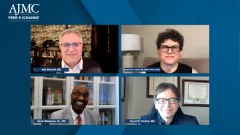
Acute Migraine Therapy Unmet Needs
Key opinion leaders briefly discuss unmet needs in the acute migraine space and how to determine when to switch from an acute agent.
Episodes in this series

Transcript:
Stephanie J. Nahas, MD, MSEd, FAHS, FAAN: One of the benchmarks of success with acute treatment is to become pain-free within 2 hours. We extrapolate that even further in modern clinical trials. For example, 1 metric is to be completely free of all symptoms. I mention that migraine is not just pain, but also sensitivity to light, noise, and odors, nausea, etc. Getting complete migraine freedom is also a goal when taking an acute drug.
For some patients, they're satisfied with just relief. That means their symptoms may not be gone, but they've gone down to a mild level. For many patients, if they can achieve that, they can still function at, or close to, 100%. Of course, we shoot for the stars. We go for total symptom freedom within that 2-hour time. Some patients will achieve that within longer periods, say 4 hours.
Some patients may still have moderate pain, but they can function. It's never 1 simple answer, and it's not just about how well the medication performs on that attack. It's how well that medication meshes with the individual. What are the adverse effects? What are the consequences of taking that drug? Are we trading 1 set of symptoms for another? Some people with migraine do all of this bargaining in their head when they decide what they want to deal with. Do I prefer the symptoms of my attack, or the adverse effects that I get from my medication which I'm not even sure is going to work, anyway? They may have to pick and choose when they're going to use their medicine.
Some people are living day-to-day with migraine and they don't have a medication that they can count on to give them relief, restore their function, and allow them to continue their activities, whether they are leisure activities or responsibilities at work or home. We aim for the patient to be able to tolerate it without substantial adverse effects. Of course, that also includes not needing that medication more than about 2 to 3 days a week, at most. Relying too heavily on acute drugs can lead to destabilization of the disease itself.
Neil Minkoff, MD: There are some interesting aspects there. What do you think is a big unmet need for patients, and how do you try to work around that?
Stephanie J. Nahas, MD, MSEd, FAHS, FAAN: Many patients will tell me that they have a drug that they count on, but they can't count on it 100% of the time. We have yet to find medications that work the majority of the time for the majority of people. Even when you look at clinical trial data, we're getting symptom freedom in about 30% of patients. That’s if we're lucky. Getting down to a mild level is possible more often. But if you survey a large population of people with migraine on triptans, for example, more than half of people who are prescribed a triptan stop it within a year and don't continue using it. Largely, that's because of lack of effect or too many adverse effects. Cost can also play a role.
Newsletter
Stay ahead of policy, cost, and value—subscribe to AJMC for expert insights at the intersection of clinical care and health economics.

















































